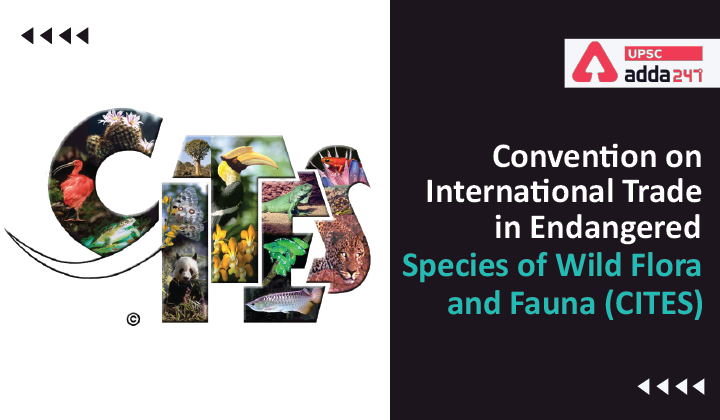Table of Contents
About CITES
- CITES meaning: CITES is a global intergovernmental agreement to regulate or ban international trade in species under threat.
- CITES is an international treaty to prevent species from becoming endangered or extinct because of international trade.
- Under this treaty, countries work together to regulate the international trade of animal and plant species and ensure that this trade is not detrimental to the survival of wild populations.
- According to CITES, any trade in protected plant and animal species should be sustainable, based on sound biological understanding and principles.
- Although CITES is legally binding on the parties, it does not take the place of national laws. Rather it provides a framework to be respected by each Party, which has to adopt its own domestic legislation to ensure that CITES is implemented at the national level.
CITES history
- In the early 1960s, international discussion began focusing on the rate at which the world’s wild animals and plants were being threatened by unregulated international trade.
- The Convention was drafted as the result of a resolution adopted in 1963 at a meeting of the IUCN in Nairobi, Kenya.
- The text of the Convention was agreed upon in Washington D.C. in 1973. Just over 2 years later, on July 1st 1975, CITES entered into force.
- Today, 182 countries and the European Union implement CITES, which accords varying degrees of protection to over 35,000 species of animals and plants.
Why is CITES needed?
- Widespread information about the endangered status of many prominent species, such as the tiger and elephants, might make the need for such a convention seem obvious.
- Annually, international wildlife trade is estimated to be worth billions of dollars and to include hundreds of millions of plant and animal specimens.
- The trade is diverse, ranging from live animals and plants to a vast array of wildlife products derived from them, including food products, exotic leather goods, wooden musical instruments, timber, tourist curios and medicines.
- Levels of exploitation of some animal and plant species are high and the trade in them, together with other factors, such as habitat loss, is capable of heavily depleting their populations and even bringing some species close to extinction.
- Many wildlife species in trade are not endangered, but the existence of an agreement to ensure the sustainability of the trade is important in order to safeguard these resources for the future.
- Because the trade in wild animals and plants crosses borders between countries, the effort to regulate it requires international cooperation to safeguard certain species from over-exploitation.
CITES COP
- The Convention of Parties (COP) to CITES is the supreme decision-making body of the Convention and comprises all its Parties.
- COP CITES meets every two-three years.
- The latest COP was CITES COP18 that took place in 2019 in Geneva, Switzerland.
- India hosted CoP (3rd) in 1981.
CITES species
| CITES Appendix UPSC | Description | Examples of Species |
| CITES Appendix 1 |
|
|
| CITES Appendix 2 |
|
|
| CITES Appendix 3 |
|
|
CITES India
- India became a member, and ratified CITES in 1976.
- India is one of the few countries to have made extensive use of Appendix III of CITES, compared to other Parties to the Convention.
- Due to the extreme diversity India possesses, India is recognized for harbouring up to 7-8% of all the species recorded by CITES in the world.
- Wildlife Crime Control Bureau is the nodal authority for the CITES implementation in India.
FAQ
Q. What is CITES full form?
Ans. CITES stands for Convention on International Trade in Endangered Species of Wild Flora and Fauna.
Q. What is CITES UPSC?
Ans. CITES is an international treaty to prevent species from becoming endangered or extinct because of international trade.



 TSPSC Group 1 Question Paper 2024, Downl...
TSPSC Group 1 Question Paper 2024, Downl...
 TSPSC Group 1 Answer key 2024 Out, Downl...
TSPSC Group 1 Answer key 2024 Out, Downl...
 UPSC Prelims 2024 Question Paper, Downlo...
UPSC Prelims 2024 Question Paper, Downlo...





